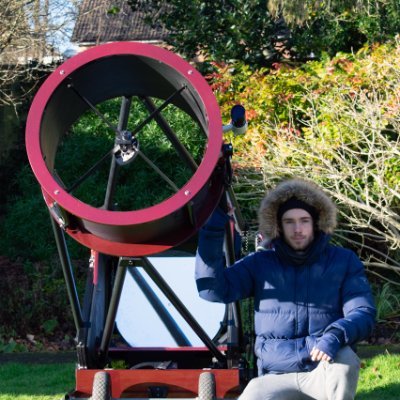
Dr Natasha Hurley-Walker
@ColourfulCosmos
Followers
2K
Following
27K
Media
366
Statuses
2K
Find me on @colourfulcosmos.bsky.social
Perth, Western Australia
Joined June 2018
I'm joining the Xodus. I can't bear what the owner of this website stands for. See you over on @colourfulcosmos.bsky.social .
0
0
3
Astronomers have detected a long-running source of slow, repeating radio pulses that can’t be explained by current theories – but it’s probably not aliens. @ColourfulCosmos from @CurtinUni has all the details 👇
theconversation.com
Astronomers have detected a long-running source of slow, repeating radio pulses that can’t be explained by current theories – but it’s probably not aliens.
1
3
9
We're hearing a lot of buzz and excitement for @ColourfulCosmos' talk at #APRIM2023 on long transients -- her plenary session is 9am local time today so don't miss it! https://t.co/jDdWAtkmQw
#atnf
aprim2023.org
APRIM 2023 will be organized in hybrid more, in-person in Koriyama City, Japan and online.In-person participants and speakers will join the conference at Big Pallet Fukushima in Japan.Virtual...
0
3
5
Astronomers have detected a long-running source of slow, repeating radio pulses that can’t be explained by current theories – but it’s probably not aliens. @ColourfulCosmos from @CurtinUni has all the details 👇
theconversation.com
Astronomers have detected a long-running source of slow, repeating radio pulses that can’t be explained by current theories – but it’s probably not aliens.
0
2
9
Astronomers have detected a long-running source of slow, repeating radio pulses that can’t be explained by current theories – but it’s probably not aliens. @ColourfulCosmos from @CurtinUni has all the details 👇
theconversation.com
Astronomers have detected a long-running source of slow, repeating radio pulses that can’t be explained by current theories – but it’s probably not aliens.
0
1
6
And I'm advertising for PhD positions, too! (Aus/NZ students only I'm afraid!)
Hey - if you're an undergrad student and want to work with @ColourfulCosmos on some of those radio transients we've been talking about, then we've got the summer project for you:
0
1
6
A long-period radio transient active for three decades, by Natasha Hurley-Walker @ColourfulCosmos and co-authors: https://t.co/m6MkCoHXYo Check out the News & Views by Victoria M. Kaspi highlighting the remarkable foresight of scientists in bygone years: https://t.co/Vv579SRZLN
2
2
12
Exciting discovery led by our partners @ICRAR-@CurtinUni using @mwatelescope, with follow up observations from fellow SKA precursors ASKAP & MeerKAT: a new type of stellar object that challenges our understanding of the physics of neutron stars!
In research published today in @nature, ICRAR astronomers using the @mwatelescope and led by @ColourfulCosmos discover what may be a 'long-period #magnetar' - a new kind of slowly spinning star whose radio emissions "shouldn’t be possible".
1
3
10
In research published today in @nature, ICRAR astronomers using the @mwatelescope and led by @ColourfulCosmos discover what may be a 'long-period #magnetar' - a new kind of slowly spinning star whose radio emissions "shouldn’t be possible".
icrar.org
An international team led by astronomers from Curtin University and the International Centre for Radio Astronomy Research (ICRAR) has discovered a new type of stellar object that challenges our...
3
26
65
This is another great example of the complementarity of radio facilities. Congrats to the international team behind the result, inc. lead author @ColourfulCosmos, co-chair of the SKAO's Extragalactic Continuum Science Working Group! Read the @Nature paper:
nature.com
Nature - The discovery of a long-period radio transient, GPM J1839–10, prompted a search of radio archives, thereby finding that this source has been repeating since at least 1988.
1
1
6
Astronomers from @ICRAR using the @mwatelescope and three @CSIRO_ATNF telescopes have discovered a new type of stellar object that upsets our understanding of neutron stars. 🌟 Here's why we're excited: https://t.co/4Cya5Lam3J 📷 | Pete Wheeler #Magnetar
0
12
43
A team of astronomers, lead by @ColourfulCosmos, used the @mwatelescope to discover a long-period radio transient that has been active for almost three decades. The object was confirmed in archival data from the #VLA and the #GMRT, with detections going as far back as 1988!
Once found by the team at@CurtinUni, the object was confirmed by observations from @CSIRO_ATNF, @SKA_Africa, @ESA_XMM & @IAC_Astrofisica – and found in archives at @TheNRAO and @NCRA_Outreach as far back as 1988.
0
1
13
Read on to hear my theory on the "aliens of the gaps" 🖖
Astronomers have detected a long-running source of slow, repeating radio pulses that can’t be explained by current theories – but it’s probably not aliens. @ColourfulCosmos from @CurtinUni has all the details 👇
0
2
9
You asked me whether we'd found any other weird slowly-repeating radio sources and all I could say was: "watch this space". Until today! We've found a new object - and this one breaks all the rules!
In research published today in @nature, ICRAR astronomers using the @mwatelescope and led by @ColourfulCosmos discover what may be a 'long-period #magnetar' - a new kind of slowly spinning star whose radio emissions "shouldn’t be possible".
3
15
89
Great to attend the Faculty of Science and Engineering Excellence 2022 Awards @CurtinUni. Many congratulations to @ColourfulCosmos who is a winner of the Mid-Career Research Award. 🥳 🎉
0
1
11
Results just released from @NANOGrav and international partners show - for the first time - the signature of long-wavelength gravitational waves rippling through space. (1/n)
14
329
2K
Fun to use some very complex and technical equipment to capture the solar eclipse today!
6
5
61
Gorgeous videos of the meteor in the comments. Enjoy! 🌠
🚨ATTENTION! A small asteroid is expected to safely impact the French-English channel in ~4 hours time, 03:00:03 UT tomorrow. Object size is around ~1 meter and should appear as bright as the Moon momentarily as it enters the atmosphere. Approx visibility circle posted below. 1/
0
1
8














